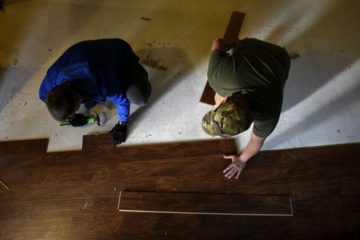During construction, the internal relative humidity (RH) of concrete plays a significant role in the progression of work. Especially in slabs-on-ground or suspended slabs that are to receive moisture-sensitive flooring materials, professionals often rely on experience to understand the drying time of field concrete. Flooring materials such as sheet rubber, epoxy coatings, vinyl composition tile, sheet vinyl, carpet, athletic flooring, laminates, and hardwood can suffer issues such as delamination, blistering, mold growth, and other similar problems due to exposure to moisture and high RH conditions in the concrete (ACI 302.2R-4). Issues like these are responsible for millions of dollars spent on litigation costs per year in affected construction projects.
Over the years, the difficulties associated with achieving precise measurements of moisture content in concrete, have been quite a challenge for professionals. The heterogeneous nature of concrete and its physical properties doesn’t help either. This problem is however catered for by the ASTM F-2170 testing method, which provides specifications for gauging the RH conditions in concrete slabs. However, various drawbacks have been identified by practitioners in the use of the ASTM F-2170 probes for monitoring RH levels in concrete.
This article examines the efficiency of embedded RH sensors in concrete. The goal is to enable flooring manufacturers as well as contractors, to better understand the drying time of field concrete, and to predict the appropriate time for flooring application. Furthermore, the study also validated the use of simple inputs which are known to practitioners and engineers, rather than existing complex formulations, to predict the RH distribution of concrete during drying.
Pore Structure of Concrete
In porous media such as concrete, moisture transport is governed by both liquid and vapor flow. The permeability of both liquid and vapor phases depends on the pore-size distribution, the tortuosity/connectivity of the pore structure, and the degree of saturation of the medium. Therefore, determining the pore size distribution is necessary to solve mass balance equations associated with concrete.

Fig. 2: Schematic of Concrete Pore Structure.
Measuring RH Levels at 20% and 40% of Concrete Depth
Considering a simple block of concrete made of normal concrete mix, RH levels were monitored with two techniques: the conventional drilled probe method as specified by ASTM F2170 using in-situ probes; and embedded Bluerock sensors. Both sensors were embedded at 40% and 20% of the depth of the block respectively, from the surface of the bottom mold. For the probes, two plastic sleeves, conforming to ASTM F2170-5 “Standard Test Method for Determining RH in Concrete Floor Slabs Using in situ Probes”, were installed to the bottom and side of the molds, at 40% of the depth from the bottom.

Fig. 3: Embedded Sensors and F1270 Sleeves Installed in Wooden Mold
One major assumption by the F2170 method is that a perfect seal would occur between the concrete and the sleeves of the probe, however, it could be difficult to maintain sealed conditions. Furthermore, since the Bluerock sensors are designed to be fully embedded, issues associated with sealed conditions are not a problem.
Embedded Bluerock Sensor vs ASTM F1270 Probes
Comparing the results of the two techniques clearly indicated a close correlation between the RH levels measured by the embedded BlueRock sensor at 20% of the concrete depth and the F2170 probe at 40%.

Fig. 4: Average RH for concrete sample, showing embedded sensors at 20% and 40% of depth as well as ASTM F2170 method drilled after 1 day and 4 months of casting.
Despite this correlation, the difference between the results of the embedded sensor at 20% and the first F2170 probes at 40% can be primarily attributed to the inability of the probes to maintain sealed conditions. To validate this limitation, a second set of probes was carefully installed through the sleeves in the concrete blocks, after 4 months. These newer probes showed an initial agreement with the embedded sensors. However, the correlation diminished gradually as the probes again lost the ability to sustain sealed conditions.
Relative Humidity inside these cavities was found to correspond to the RH at 15 to 25% of the concrete depth, when the cavity is at 40% of the concrete depth. As the difference in humidity between the concrete and the cavity decreases, the humidity gradient in the vicinity of the cavity decreased significantly, leading to the concrete around the cavity not being representative of the concrete elsewhere at the same depth.
To illustrate the phenomena, the figures below demonstrate the concrete block drying behaviour at 25, 50 and 200 days.

Fig. 5: Two-dimensional section cuts of simulated geometry showing distribution of humidity throughout geometry and inside cavity (black borders).
The humidity around the cavity is shown to be significantly different from elsewhere in the concrete block. This has been found to be primarily due to two forces attempting to come to an equilibrium around the cavity: first, the difference in water vapor capacity of the large cavity and the surrounding concrete porosity, as well the higher diffusivity of the vapor phase in the cavity compared to the concrete. The second force is caused by the pressure gradient along the concrete depth of the concrete (due to drying).
The experimental and numerical evidence provided in this work for the first time clearly indicates the nature of measuring concrete RH at a specific depth using the F2170 method. The F2170 method was observed to be extremely under-conservative and could fail in estimating the correct RH at the specific depth of interest.
What to Consider When Choosing RH Measurement Technique
With a better understanding of the behaviour of various RH measurement techniques, flooring manufacturers as well as contractors, can make better judgements of the drying time of field concrete, and predict the appropriate time for flooring applications. Embedded RH sensors such as BlueRock Sensors by Giatec are as effective for measuring RH levels at 20% of concrete depths, just as F2170 probes at 40% depth. The sensor also provides an extended monitoring duration of up to two (2) years. Furthermore, due to effects of cavities around drilled sleeves in concrete, measured RH values of F2170 probes installed at 40% depth tend to be under-conservative, and more representative of the RH values at 15% – 25% depth, rather than the specific depth of interest of 40%. Therefore, practitioners need to be very careful with their set ups, when using this technique for measuring relative humidity in concrete receiving moisture-sensitive flooring materials.
Sources:
- Understanding Relative Humidity in Concrete | Giatec Scientific Inc.
- ASTM F2170-5 “Standard Test Method for Determining RH in Concrete Floor Slabs Using in situ Probes”
- ACI 302.2R4 “Guide to Concrete Floor and Slab Construction”.
- Sarah De Carufel, Andrew Fahim, Pouria Ghods, and Rouhollah Aalizadeh (2019), Numerical Simulation of Internal Relative Humidity of Concrete Exposed to Drying. ACI Materials Journal, V. 117, No. 6, November 2020. MS No. M-2019-449.R1, doi: 10.14359/51728146.








